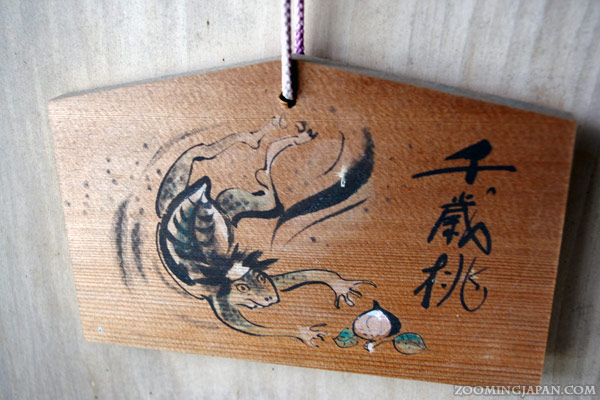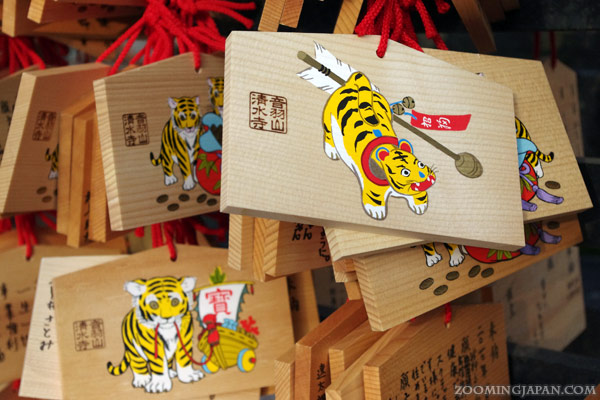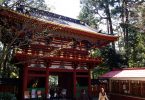Today I want to introduce “Ema” (絵馬) which are wooden wishing plaques of Japanese shrines.
I’m sure most of you have seen them when visiting Japan or on various photos, but you weren’t sure what exactly they are or what they’re called?

What exactly are “ema”?
“Ema” are wooden wishing plaques.
This is a Shinto custom and thus can be found at shrines all over Japan.
As Buddhism and Shinto have mixed up a lot, it is not unique to shrines. You MIGHT find them in temples, too!
In recent days people write their wishes or prayers on a wooden plaque that can be purchased at the shrine and then hang it up on the shrine grounds.
But where does this tradition come from?

The origins of “ema”
“Ema” consists of two kanji: 絵馬; the one for “picture” and the one for “horse“.
Horses were seen as the “vehicles of gods” (神の乗り物) and during the Nara period (710-784) people donated horses to the shrines so that the gods would be more likely to listen to their prayers and fulfill wishes.
However, horses were expensive and thus people who couldn’t afford it used horse figures made of wood, clay or paper instead. Finally the wooden wishing plaques with a picture of a horse on them were born.
During the Muromachi period (1336-1573) certain shrines started to display other things besides the horses, e.g. foxes at Inari Shrines.
Later during the Azuchi-Momoyama period (1568-1603) there were even “ema halls” (絵馬堂) where various artists displayed their ema design work. This can be compared to our modern art galleries.

In the Edo period (1603-1868) it finally became common that individuals could purchase very small plaques to communicate their wishes to the gods more conveniently.
The different ema designs
Nowadays there are all sorts of pictures displayed. Very common is the current year’s zodiac (e.g. 2012 was the year of the dragon, so you’d see a lot of dragon pictures). Very often it’s the picture of a god or spirit that’s connected to the shrine.

However, in recent days basically EVERYTHING is possible. I’ve seen various anime and even Rilakkuma ones!! I guess those are especially popular among little kids. Very often you’ll find more than just one picture per shrine, especially in bigger ones.
When it is exam season, you’ll find mostly “goukaku” (合格) wooden wishing plates. Students all over their country wish that they’ll pass their tests.
Very common is also to pray for success in the next sport event, health, love, safe childbirth.
How to properly use an “ema”
Anyone can purchase the plaques. Usually they cost around 500-1000 yen. You purchase them at the small booth where you can also get a seal in your seal book or lucky charms. If nobody is around you just put the money in a box and take one of the plaques.
Yes, that’s Japan!
I guess they’re not worried that anybody would take one without paying! 
With the money the shrine is also supported financially.

It’s not difficult to fill out an “ema”. There are no strict rules. Sometimes you’re supposed to write your wish on the front, you basically overwrite the picture and you can write your name and address on the back. For others you don’t touch the picture side, but write your wish on the back.
In big cities such as Tokyo you’ll find a lot of foreign languages on those plaques! A good place to check them out is Meiji Shrine!
If you’re interested to see more ema designs and want to know some more details, please proceed to PAGE 2! 








Thanks for this very interesting post!
Now I regret that I haven’t paid more attention to those emas when I visited shrines. I will from now on. I can tell you the one I would definitely buy as a souvenir: the one with the arrow about to be shot at the fan at Dan no Ura, since Yoshitsune is a particular interest of mine. [did you see his little shrine at Hiraizumi?]
Many are lovely, with a favorite being the swimming frog in the second picture.
In Hiraizumi? You mean Motsuji with the great stone garden in the big pond? Yes, I did! :thumbup:
May I ask why you’re so interested in him?
There are so many beautiful or interesting ones out there.
I can’t leave a shrine (or temple) before I haven’t checked out the ema! ;P
Oooooh, I really like the Ema with “WORLD PEACE” written on it :) I think I might do one like that next time I’m in Japan. Keeping those gods at work with some more difficult goals can’t be too bad :)
Yes, that’s actually the reason why I took the photo!
This was RIGHT before the Great Earthquake and Tsunami in 2011. :(
I guess people wished for other things after that happened …. as they had other things to worry about.
I remember that I always mentioned World Peace when I was asked as child what my wish(es) would be if I had some. :hihi:
You have a collection of ema photos! It’s interesting that you wrote where those photos of ema were taken from. I wonder though why you didn’t include the torii ema of Fushimi Inari Shrine. They’re unique. :hum:
I still have to see anime characters printed on ema one day. :whyohwhy:
Yes, I thought it’s interesting if somebody wants to know where they could find them.
Ahahaha~ sorry! :sweatdrop:
They are quite unique indeed, but I wanted to stick to “normally shaped” emas in this post.
There are other inari shrines with differently shaped ems. I found one with two foxes shaped as a heart, too. So cute! :happy:
They’re getting more and more popular recently, so you’ll surely run into a few soon! :thumbup:
Big Mahalo…very informative…..wish I had read this before my last trip to Japan. In the future, I will be looking at all of them more carefully….
Don’t worry. At first I also had no clue what they were, although it’s quite easy to figure out.
It took a few years until I became an ema fan.
Now I can’t visit a shrine (or temple) wihtout checking out the ema there carefully! :shiawase:
Those Rilakkuma ema are so cool! Nice post! (^_^)v
Great post! And you explain in good detail what the ema are.
In Kyoto, there is a popular restaurant in Gion that displays erotic ema, lol. I have pics from there. Pretty funny stuff.
Oh, that sounds interesting.
I don’t think I ever came across those. I’m sure they were an experience! *g*
[…] Dużo zdjęć różnokolorowych ema tutaj […]
[…] by the Ema wooden wishing plates that are displayed at Shinto temples and shrines. Here is an interesting blog post describing their history and styles. I always like to look at the calligraphy but also spot the […]
This is one of the most extensive blog posts I have read and seen on ema. Thank you for taking the time to put this together. The pics you took are beautiful!
Thanks so much! Glad you think so! ;P
How or where can I get them (EMA plaques) outside Japan.
thx KateB
Hi, Kate.
Sorry for the late reply.
I’m not sure you’d be able to find ema outside of Japan. It’s not something you can just buy in an online shop if that’s what you meant.
They have a religious meaning and you get them at shrines and temples and usually you leave them behind there.
It’s not something you purchase to keep, although I sometimes do to keep them as a souvenir. ;)
Hi,
Great post thank you! The only thing I wonder is what happens to the tablets? I was at Meiji Shrine in Tokyo and there are a lot of these tablets!
Are they just thrown away? When? Do you know?
Thanks.
Hi Andy!
A very good question. After some time they take down old ema. There’s a ritual in which they burn them.
In Shinto (the traditional Japanese religion) people think that everything posseses a spirit, so you can’t just throw them away.
Usually old charms, protection items and also ema are burned in a ritual following “hatsumode” (the first visit of a shrine).
[…] Writing Ema wishes in front of the shrine. […]
[…] more: many ema hanging at the shrine are decorated with some Girls und Panzer fanart… Ema are wooden plaques where people visiting Shinto shrines can write their wishes. They usually look like […]
[…] Background: ““Ema” (絵馬) are wooden wishing plaques. This is a Shinto custom and thus can be found at shrines all over Japan…[…]… In recent days people write their wishes or prayers on a wooden plaque that can be purchased at the shrine and then hang it up on the shrine grounds.” (http://zoomingjapan.com/wiki/ema/) […]
I love this! I feel I didn’t get to see such amazing Ema while I was in Japan. I saw very simple and traditional types, the inari fox ones, the monkeys, rabbits…Never a Rilakkuma or a round blue “yume” Ema, for example. I was thinking before you said it, that I wonder if it’s common for people to bring the plaques home instead of leaving them at the shrine/temple. I wonder if it might be seen as ‘ruining’ the luck the Ema are said to bring.
There are a lot of people in Japan who believe in fortune telling and lucky charms, so they would never do anything that COULD bring them bad luck.
If you’re worried about something like that, then don’t take an ema home, but in my opinion as long as you haven’t written a wish on the ema you’re taking with you, I don’t see a problem. :)
The ones where you actually write something on, you should definitely leave at the shrine / temple! ;)